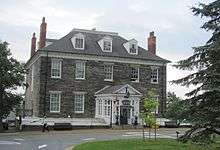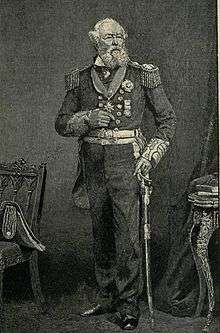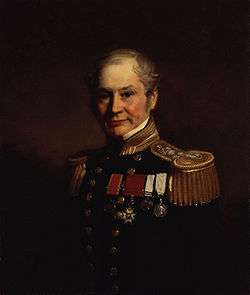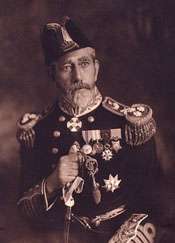CFB Halifax
| CFB Halifax - former Royal Naval Dockyard, Halifax | |
|---|---|
| Halifax, Nova Scotia, Canada | |
|
HMCS Fredericton (FFH 337) docked at CFB Halifax | |
| Coordinates | 44°39′23.63″N 63°34′44.69″W / 44.6565639°N 63.5790806°WCoordinates: 44°39′23.63″N 63°34′44.69″W / 44.6565639°N 63.5790806°W |
| Type | Naval base |
| Site information | |
| Controlled by | Canadian Forces |
| Site history | |
| In use | 1759-present |
| Garrison information | |
| Garrison | Maritime Forces Atlantic |
Canadian Forces Base Halifax (CFB Halifax) is Canada's east coast navy base and home port to the Atlantic fleet, known as Maritime Forces Atlantic.
It is the largest Canadian Forces Base in terms of the number of posted personnel and is formed from an amalgamation of military properties situated around the strategic Halifax Harbour in Nova Scotia.
Her Majesty's Canadian Dockyard (HMC Dockyard Halifax)
History
HMC Dockyard Halifax was acquired by the Canadian government from the Royal Navy following the withdrawal of British military forces from Canada in 1906. Prior to 1906, it was known as Royal Naval Dockyard, Halifax and is one of the oldest defence establishments in Canada, having been established by the Royal Navy during the 18th century as HM Dockyard. While awaiting transfer to Canada, the dockyard fell into disrepair. The dockyard was formally taken over from the British government by Canada in 1910, with no changes to the layout. The dockyard in 1910 comprised a Naval Hospital, a blacksmith shop, workshops, three slipways, five jetties, residences, coal and vitualling stores and 75 other miscellaneous buildings.[1]
During World War I, the dockyard underwent significant expansion, acting as headquarters for the Royal Canadian Navy and as the North American headquarters for the Royal Navy. During the 1917 Halifax Explosion, the dockyard was severely damaged, with many of its buildings demolished. New ones were swiftly erected for the war effort. However, following the end of the war in 1918, the number of dockyard staff was reduced significantly.[1]
In 1939, the dockyard's were extended to the north and south. With the onset of World War II, this was still not large enough and the lands of the French Cable Company in Dartmouth, Nova Scotia were acquired and integrated into the base. In 1942, the Royal Canadian Navy acquired the Army Ordnance Depot in Dartmouth and an area on the east side of Bedford Basin was turned into an ammunition depot. During the war, new construction replaced nearly every building that had existed prior to the war. HMC Dockyard encompassed 1,255 acres after all the acquisitions. In 1943, the dockyard's lands were augmented with property in Renous, New Brunswick and another ammunition depot at Newcastle, New Brunswick. The Army Gun Wharf in Halifax became the victualling depot and two communications stations were established, one at Albro and one at Newport Corners. The barracks building that became HMCS Scotian was erected during the war.[1]
In 1948, the Maritime Museum of the Atlantic was established on the premises of the dockyard. In the 1950s, an Underwater Training Unit, the School of ABCD Warfare and the Damage Control School were under the administration of HMCS Stadacona and operated out of dockyard facilities. The dockyard maintained a 35-ton lift crane on Jetty 3, a 45-ton lift crane on Jetty 4 and a 50-ton lift crane on the Gun Wharf. In 1953, a seaward defence base was constructed between Pier "B" and the yacht anchorage in the south end of Halifax.[1]
Current status
HMC Dockyard Halifax is located on the western side of Halifax Harbour at the southern end of The Narrows. It hosts the headquarters of Maritime Forces Atlantic (MARLANT), the formal name for the Atlantic Fleet. HMC Dockyard Halifax contains berths for Canadian and foreign warships, Formation Supply Facility, Fleet Maintenance Facility Cape Scott, shore-based training facilities as well as operations buildings for MARLANT and other organizations such as Joint Rescue Coordination Centre Halifax (JRCC Halifax).
HMC Dockyard Halifax also has an adjunct facility directly across the harbour on the Dartmouth shoreline with jetties and various buildings, including Defence Research and Development Canada - Atlantic.
HMC Dockyard Halifax maintains exclusive control of several anchorage areas within the limits of Halifax Harbour and prevents civilian vessels from sailing in the vicinity of military facilities; a floating force protection boom system was constructed to prevent small vessels from unauthorized passage near warships and pierside facilities.
The original Naval Yard clock has been restored and moved to the Halifax Ferry Terminal entrance while the original Naval Yard bell is preserved at the Maritime Museum of the Atlantic in Halifax, a museum which also features a large diorama depicting the Naval Yard in 1813 at its height in the Age of Sail. The dockyard was designated a National Historic Site of Canada in 1923,[2] while Admiralty House was designated a National Historic Site in 1978.[3]
Stadacona
Stadacona, referred to as HMCS Stadacona before 1968 and frequently referred to as "Stad", is an adjunct to HMC Dockyard located west of the waterfront in the North End of the Halifax peninsula. Prior to the arrival of the French, the location that would become Quebec was the home of a small Iroquois village called "Stadacona", after which the base is named.[4] Stadacona contains the Canadian Forces Naval Engineering School (with facilities at Herring Cove/York Redoubt, south of Halifax), the Canadian Forces Naval Operations School, the base hospital, the Canadian Forces Maritime Warfare Centre, and various messes. Stadacona is also home to the headquarters of 5th Canadian Division and the Maritime Command Museum.
Stadacona was built as the British Army's Wellington Barracks, later known as the Nelson Barracks, as part of the Halifax Defence Complex. The British military forces departed from Canada in 1906. During the Second World War, the Royal Canadian Navy appropriated the site from the army and it was transformed into HMCS Stadacona.
 Stadacona Entrance. Building demolished in March 2013.[5]
Stadacona Entrance. Building demolished in March 2013.[5] Wellington Barracks
Wellington Barracks Leonard W. Murray (CFNOS) Building CFB Halifax
Leonard W. Murray (CFNOS) Building CFB Halifax- Gravestones for casualties of HMS Shannon's Capture of USS Chesapeake
 Battle of Trafalgar mural by William Lionel Wyllie, Juno Tower
Battle of Trafalgar mural by William Lionel Wyllie, Juno Tower HMHS Llandovery Castle (210 dead, 24 survivors, June 1918) Plaque, Stadacona Health Centre
HMHS Llandovery Castle (210 dead, 24 survivors, June 1918) Plaque, Stadacona Health Centre HMCS Lady Nelson - returned 25,000 wounded from battlefront in Second World War, Commemoration Display, Stadacona Health Centre
HMCS Lady Nelson - returned 25,000 wounded from battlefront in Second World War, Commemoration Display, Stadacona Health Centre
Historic structures
Admiralty's Residence
Almost all the original Royal Navy 18th and 19th century buildings were demolished in the Second World War to make way for machine shops, stores buildings and drill halls needed to man and maintain the hundreds of corvettes being commissioned during the crash expansion of the Royal Canadian Navy during the Battle of the Atlantic. Only one residence from 1814 and the Admiral's Residence from 1819 survived. The Admiral's residence (Admiralty House) is now the Maritime Command Museum.
Wellington Gate

Wellington Gate was created in 1850 and named after Arthur Wellesley, 1st Duke of Wellington. The gate is lined on either side with two columns of Battles and Campaigns fought by Canadian Forces. The two columns read from left to right:
- Saskatchewan/Northwest Canada, 1885
- Paardeberg/South Africa, 1899-1900
- Ypres, 1915-1917/Mount Sorrel
- Somme, 1916/Ancre Heights
- Vimy, 1917/Hill 70
- Passchendale/Amiens
- Hindenburg Line/Pursuit to Mons
- Landing in Sicily/Motta Montecorvino
- San Leonardo/Ortona
- Hitler Line/Gothic Line
- Lamone Crossing[6]/Rimini Line
- Italy, 1943-1945/Northwest Europe, 1945
- "Korea, 1951-1953" (plaque posted on the door).
Admiralty Garden

The Admiralty Garden was created c. 1814 and has plaques and monuments displayed to honour persons and mark events, significant to Halifax's naval history. In 1972 the "Wall of Valour" was created to recognize the bravery decorations awarded to members of the Canadian Navy and the Naval Reserves. They are listed as follows:
- Vaino Olavi Partanen CV CD[7] (HMCS Kootenay disaster)
- Lewis John Stringer, CV CD, Dartmouth, Nova Scotia[8] (HMCS Kootenay disaster)
- Amédéo Garrammone CV[9]
- Sub-Lieutenant David Peter Finch, S.C., Halifax, Nova Scotia[10]
- Chief Warrant Officer John Lorne McIntosh, M.M.M., S.C., C.D., Dartmouth, Nova Scotia[11]
- Petty Officer Patrick Garfield Marsh, S.C., Middle Sackville, Nova Scotia[12]
- Petty Officer 2nd Class James Anthony Leith, S.C., M.S.M., C.D., Shearwater, Nova Scotia[13]
- Lieutenant (N) Rodney Kenneth Druggett, M.B., C.D., Lawrencetown, Nova Scotia[14]
- Petty Officer 2nd Class John George Yurcak, M.B., C.D., Ellershouse, Nova Scotia[15]
- A/SLt Allan Herbert Brannen, M.B., Barrington, Nova Scotia[16]
- Ordinary Seaman Joseph Jean-Pierre Patrick Breton, M.B., Shelburne, Nova Scotia[17]
There are plaques of Historic Sites and Monuments Board of Canada to commemorate the following:
- George Edward Watts - War of 1812
- Philip Westphal - War of 1812
Faith Centre
The Faith Centre has numerous plaques and stainglass windows that are dedicated to naval personnel who died from Nazi U-Boats torpedoing ships in the Battle of the Atlantic (1939-1945) unless otherwise indicated.
Windows
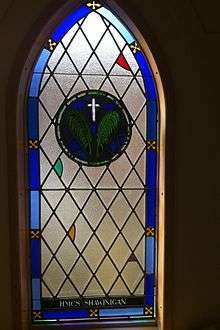 Window for HMCS Shawinigan - 85 dead, 0 survivors (torpedoed off Cape Breton, November 1944)
Window for HMCS Shawinigan - 85 dead, 0 survivors (torpedoed off Cape Breton, November 1944) Window for HMCS Clayoquot - 8 dead (torpedoed off Halifax Harbour, December 1944)
Window for HMCS Clayoquot - 8 dead (torpedoed off Halifax Harbour, December 1944)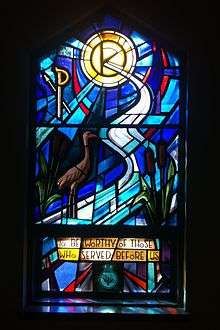 Window for HMCS Kootenay (1969) - 9 dead
Window for HMCS Kootenay (1969) - 9 dead
- HMCS Charlottetown - 9 dead
- HMCS Louisburg - 38 dead, 47 survivors
- HMCS Valleyfield - 125 dead, 38 survivors
Exterior plaques

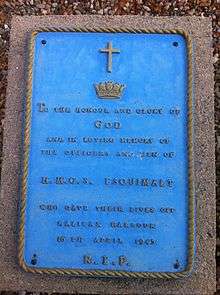 HMCS Esquimalt memorial plaque - 44 dead (torpedoed off Halifax Harbour, April 1945)
HMCS Esquimalt memorial plaque - 44 dead (torpedoed off Halifax Harbour, April 1945)


First World War
- HMS Indefatigable - Engineer Lieutenant Stanley Nelson De Quetteville (Battle of Jutland, 1916)
- HMS D3 (submarine) - Lieutenant (RCN) William McKinstry Heriot-Maitland-Dougall (friendly fire, 1918)
Second World War
- HMCS Fraser - 45 dead, 100 survivors (accident, June 1940)
- HMCS Bras d'Or - 30 dead, 0 survivors (lost in storm, October 1940)
- HMCS Margaree -142 died, 34 survivors (accident, October 1940)
- HMCS Otter - 19 dead, 22 survivors (accident, March 1941)
- HMCS Lévis (September 1941)
- HMCS Windflower - 23 dead, 62 survivors (December 1941)
- HMCS Spikenard 77 dead, 8 survivors (February 1942)
- HMCS Charlottetown - 9 dead (September 1942)
- HMCS Raccoon - 37 dead, 0 survivors (September 1942)
- HMCS Ottawa (September 1942)
- HMCS Weyburn (hit a mine, February 1943)
- HMCS Louisburg - 38 dead, 47 survivors (February 1943)
- HMCS St. Croix - 65 dead, 82 survivors (September 1943)
- HMCS Chedabucto - 1 dead (accident, October 1943)
- HMCS Athabaskan - 128 dead, 83 taken prisoner and 44 rescued (April 1944)
- HMCS Valleyfield - 125 dead, 38 survivors (May 1944)
- HMCS Regina (August 1944)
- HMCS Alberni - (August 1944)
- HMCS Shawinigan - 85 dead, 0 survivors (November 1944)
- HMCS Clayoquot - 8 dead (December 1944)
- HMCS Trentonian - 6 dead (February 1945)
- HMCS Guysborough - 51 dead (March 1945)
- HMCS Skeena - 15 dead, 164 survivors (lost in storm, October 1945)
Korea
- HMCS Iroquois - 3 naval Korean War casualties (1952)
Royal Navy Burying Ground
The Royal Navy Burying Ground at Halifax has monuments to those served and lost in the medical facility as a result of capture of USS Chesapeake by HMS Shannon. There are 84 grave markers, but as many as 500 people buried.[19] [20][21][22] [23] [24][25][26]
Shearwater Heliport
Shearwater Heliport is an airfield located on the eastern shore of Halifax Harbour in the community of Eastern Passage that supports CH-124 Sea King helicopters used on the RCN's warships based at CFB Halifax.
Formerly a separate base known as CFB Shearwater, the airfield was realigned as part of CFB Halifax during the mid-1990s. 12 Wing, a Royal Canadian Air Force unit that reports to 1 Canadian Air Division, is the primary user of the Shearwater Heliport and is headquartered there. DND properties that were formerly aligned to CFB Shearwater, such as the Hartlen Point Golf Course and the Shearwater Jetty, are now part of CFB Halifax.
12 Wing operates from two locations with four squadrons:
- Shearwater Heliport
- 406 Maritime Operational Training Squadron is an operational training squadron for training all maritime helicopter aircrew in the Canadian Forces.
- 423 Maritime Helicopter Squadron is an operational squadron at Shearwater Heliport which provides CH-124 Sea King helicopters for Maritime Forces Atlantic warships.
- 12 Air Maintenance Squadron provides aircraft maintenance and engineering support to 12 Wing's operational squadrons.
- Helicopter Operational Evaluation and Test Facility (HOTEF) is responsible for researching and testing state-of-the-art equipment for the CH-124 Sea King to enable crews to operate efficiently, ashore or while deployed.
- Patricia Bay Heliport
- 443 Maritime Helicopter Squadron is an operational squadron which provides CH-124 Sea King helicopters for Maritime Forces Pacific warships.
Royal Artillery Park

Royal Artillery Park (Halifax) is a military park, which is part of CFB Halifax, Nova Scotia. In the far corner of the Royal Artillery Park, a diminutive red brick building, is the Cambridge Military Library. This building was the social and literary centre of military Halifax. The Library opened in 1817 at Grafton Street, as an alternative to the more notorious choices of city entertainment. It moved to its present location in Royal Artillery Park in 1886 and was renamed Cambridge Military Library in 1902. The library was funded in part from Customs receipts gathered during the War of 1812 at the Battle of Hampden.
CFAD Bedford
The Canadian Forces Ammunition Depot Bedford, informally referred to as the "Bedford Magazine", is a major Canadian Forces property occupying the entire northern shore of Bedford Basin. It houses all of the ordnance for MARLANT vessels and has a loading jetty and several nearby anchorages.
HMCS Trinity
HMCS Trinity is the organization housed at Stadacona which is tasked with maintaining MARLANT communications with vessels and other Canadian Forces and allied units, as well as developing strategic and tactical operational intelligence for unit commanders.
HMCS Trinity operates two remote radio transmitter/receiver stations near Halifax:
Windsor Park
Windsor Park contains the Military Police Department, Health Promotion Services (PSP), The Auto Club, Integrated Personnel Service Centre (IPSC),the Military Family Resource Centre, CFB Curling Club as well as the Canex.
Housing
Housing for CFB Halifax is provided to Canadian Forces personnel and their dependants at Windsor Park, a housing area built by the Department of National Defence in the West End of Halifax. Stadacona is home to the Atlantic Block, a barracks for single ratings. Base housing also used to be provided at Shannon Park and Wallis Heights in the North End of Dartmouth, however with defence cutbacks in the 1990s, this area has been sold for civilian use. Housing is available at the 12 Wing Shearwater site, which is part of CFB Halifax. A large number of service personnel own or rent civilian property in the area.
Commemorations and monuments
- Wallis Heights, Nova Scotia and Provo Wallis St. is named after Nova Scotian Provo Wallis
- Stadacona is the aboriginal name for Quebec City
- Monuments in the graveyard to HMS Shannon and USS Chesapeake
- Wellington Barracks named after Arthur Wellesley, 1st Duke of Wellington, renamed Nelson Barracks named after Horatio Nelson
- Shannon Park is named after HMS Shannon
- the Murray Building (CFNOS) is named after Admiral Leonard W. Murray
- the Carroll Building (CFNOS) is named after LCdr George Alvin Carroll (1921- 1963), born Stockton, Manitoba, Distinguished Service Medal[27]
- Lady Nelson Road is named after HMCS Lady Nelson that was hit by U-161[28]
See also
| Wikimedia Commons has media related to CFB Halifax. |
References
- 1 2 3 4 "Gateway to the North Atlantic". The Crowsnest. Vol. 6 no. 2. Queen's Printer. December 1953. pp. 4–6.
- ↑ Halifax Dockyard National Historic Site of Canada. Canadian Register of Historic Places. Retrieved 9 March 2013.
- ↑ Admiralty House National Historic Site of Canada. Canadian Register of Historic Places. Retrieved 22 August 2012.
- ↑ Bumsted, J. M. Canada's Diverse Peoples: A Reference Sourcebook. Santa Barbara, CA: ABC-CLIO, 2003. 35.
- ↑ This article from CBC News presaged the changes, though no official announcement was (apparently) made: "Commissionaires may be affected in 'deep' DND cuts", CBC News, February 22, 2013
- ↑ "Lamone Crossing". Canada at War. Retrieved 21 October 2014.
- ↑ Office of the Governor General of Canada & Search: Decorations for Bravery Recipients List, CWO Vaino Olavi Partanen, C.V. , C.D.
- ↑ Office of the Governor General of Canada & Search: Decorations for Bravery Recipients List, Sergeant Lewis John Stringer, C.V., C.D.
- ↑ Office of the Governor General of Canada & Search: Decorations for Bravery Recipients List, Sergent Amédéo Garrammone, C.V.
- ↑ Office of the Governor General of Canada & Search: Decorations for Bravery Recipients List, Sub-Lieutenant David Peter Finch, S.C.
- ↑ Office of the Governor General of Canada & Search: Decorations for Bravery Recipients List, Chief Warrant Officer John Lorne McIntosh, M.M.M., S.C., C.D.
- ↑ Office of the Governor General of Canada & Search: Decorations for Bravery Recipients List, Petty Officer Patrick Garfield Marsh, S.C.
- ↑ Office of the Governor General of Canada & Search: Decorations for Bravery Recipients List, Petty Officer 2nd Class James Anthony Leith, S.C., M.S.M., C.D.
- ↑ Office of the Governor General of Canada & Search: Decorations for Bravery Recipients List, Lieutenant (N) Rodney Kenneth Druggett, M.B., C.D.
- ↑ Office of the Governor General of Canada & Search: Decorations for Bravery Recipients List, Petty Officer 2nd Class John George Yurcak, M.B., C.D.
- ↑ Office of the Governor General of Canada & Search: Decorations for Bravery Recipients List, A/SLt Allan Herbert Brannen, M.B.
- ↑ Office of the Governor General of Canada & Search: Decorations for Bravery Recipients List, Ordinary Seaman Joseph Jean-Pierre Patrick Breton, M.B.
- ↑ "First Canadian Casualties in the RCN". The War at Sea. 24 December 2001. Retrieved 21 October 2014.
- ↑ "Unmarked graves sought in navy cemetery". CBC. 18 July 2011. Retrieved 21 October 2014.
- ↑ https://archive.org/stream/navalchronicleco27londiala#page/176/mode/1up/search/halifax
- ↑ https://archive.org/stream/navalchroniclefounse_1#page/263/mode/1up
- ↑ https://archive.org/stream/navalchroniclefounse_1#page/512/mode/1up/search/halifax
- ↑ https://archive.org/stream/navalchronicleco30londiala#page/84/mode/1up/search/halifax
- ↑ https://archive.org/stream/navalchronicleco30londiala#page/360/mode/1up/search/halifax
- ↑ https://archive.org/stream/navalchronicleco30londiala#page/447/mode/1up
- ↑ https://archive.org/stream/navalchronicleco30londiala#page/359/mode/1up/search/halifax
- ↑ "Carroll". Awards to the Royal Canadian Navy. Retrieved 21 October 2014.
- ↑ Helgason, Guðmundur. "Lady Nelson (Canadian Steam passenger ship)". German U-boats of WWII - uboat.net. Retrieved 21 October 2014.
